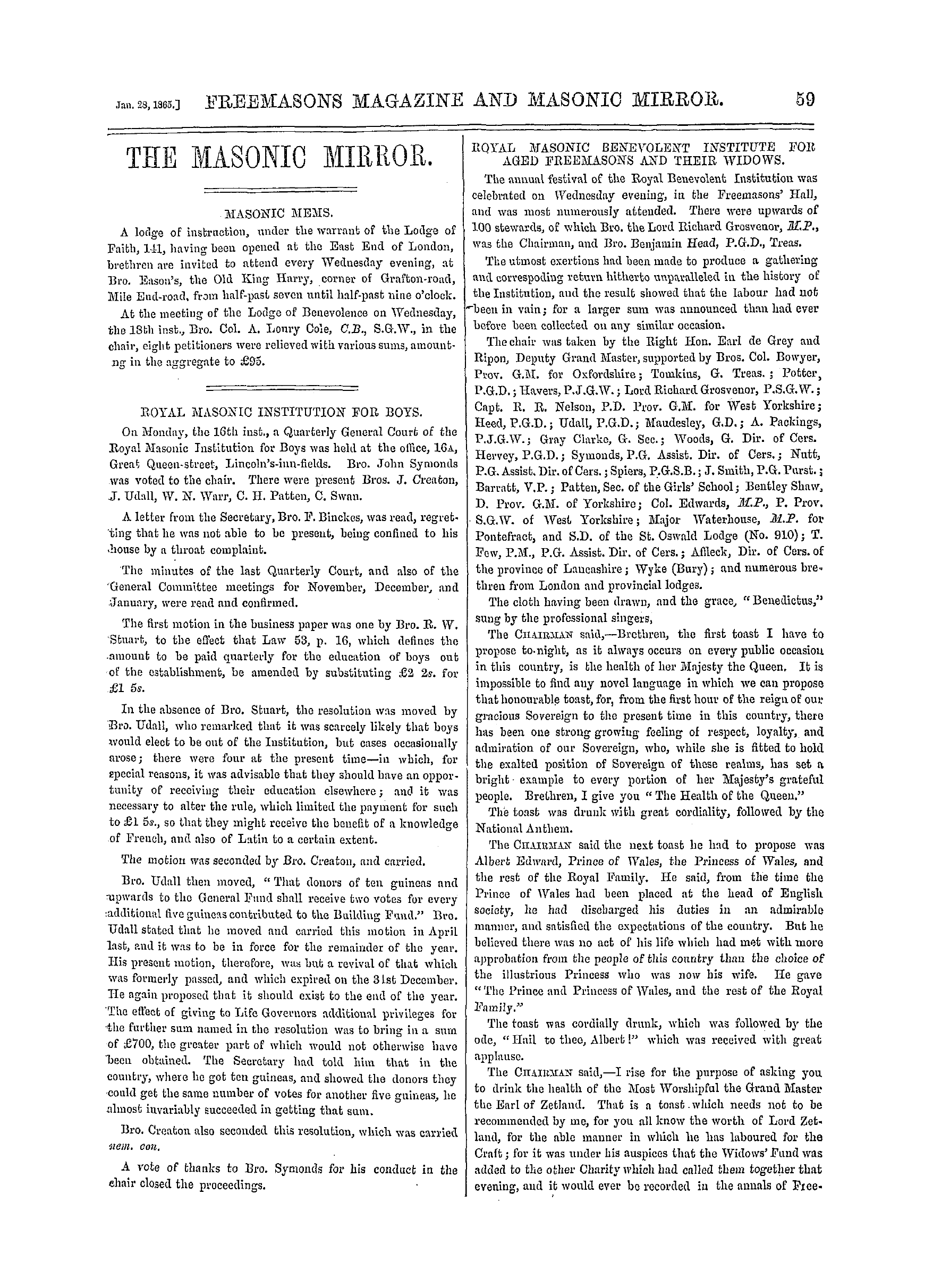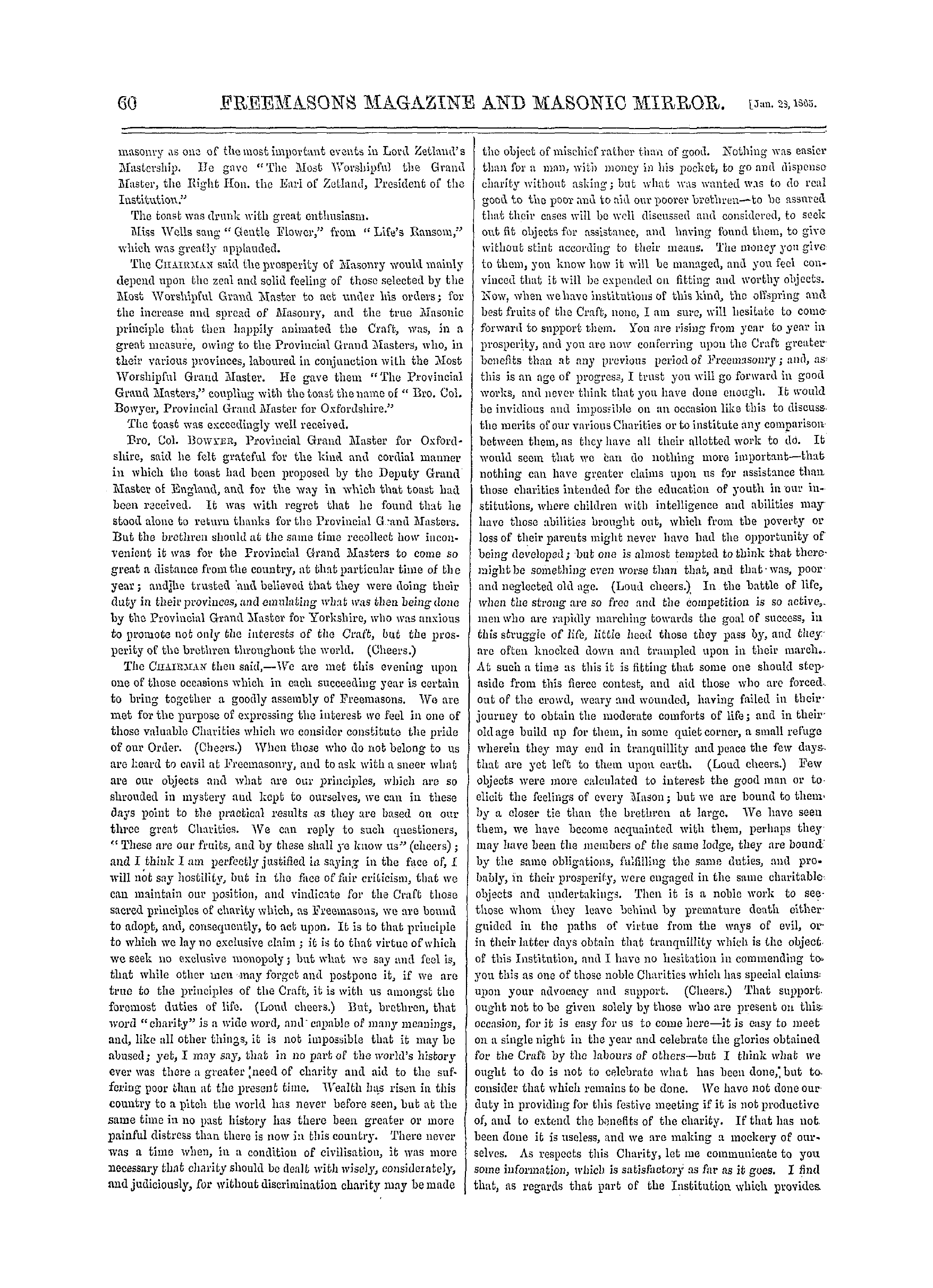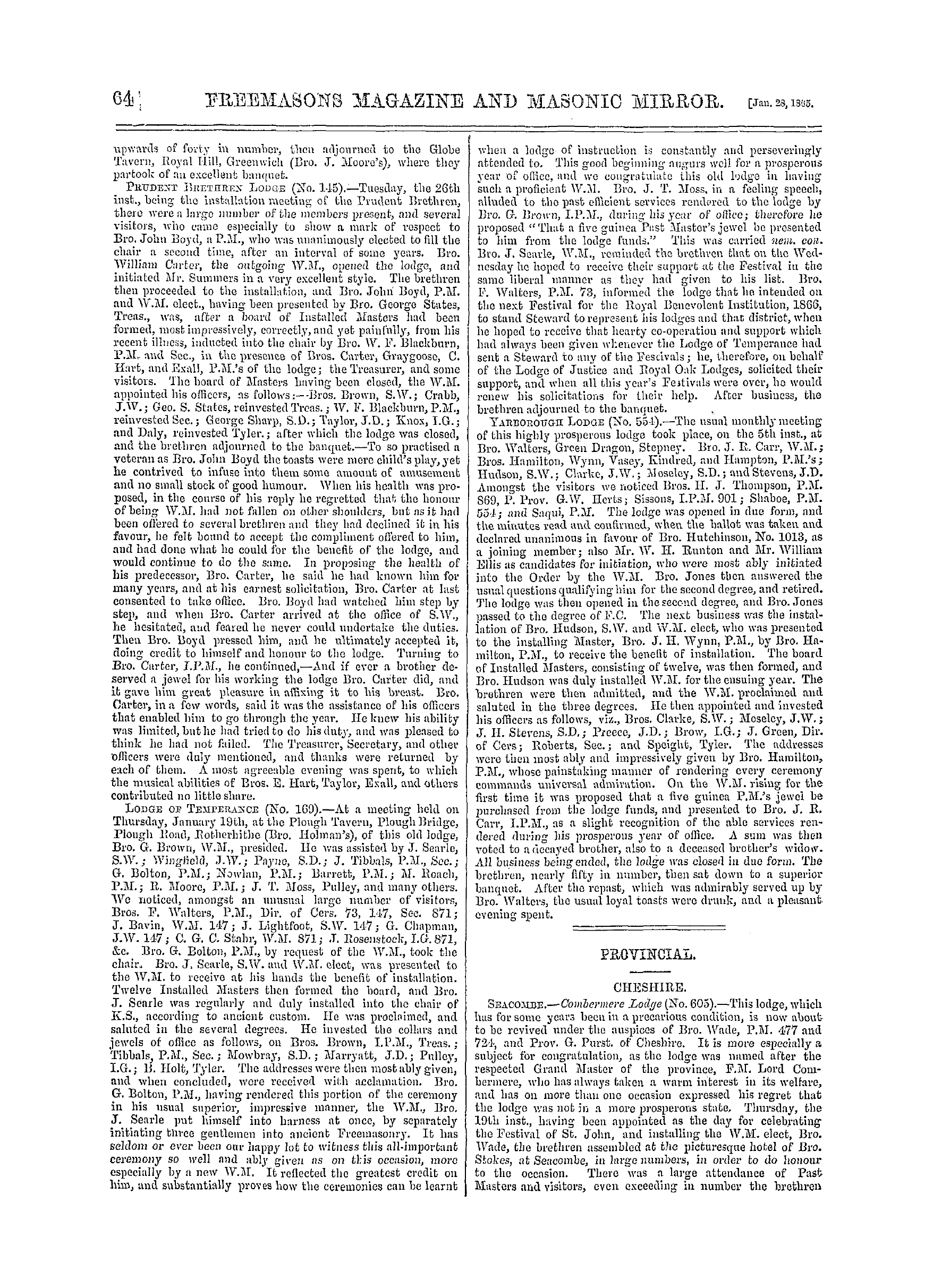Note: This text has been automatically extracted via Optical Character Recognition (OCR) software.
German Masonry In The United States.
many years past . The lodge is thi'iving , and prospering veiy much under the able leadership of this active brother . Its meetings are held usually on the second Monday in every month . The following are the names of the dignitaries : —Bros .
Bernhard Ofner , W . M . ; Ferdinand Burger , S . W . ; 0 . Robinson , J . W . ; Jacob Robinson , Treas . ; and Julius Josephson , Sec .
Block-Sinking; Or Brick And Mortar Reminiscences In The East.
BLOCK-SINKING ; OR BRICK AND MORTAR REMINISCENCES IN THE EAST .
( Concluded from page 37 , ) To convey some idea of the importance of the work for Avhich all these 298 blocks were required , and which , if put one on the top of another , would make a column above 9 furlongs high , it is necessary to state that they were intended to
carry the piers and abutments of a work comprising fifteen tunnels , each 192 ft . long , and through which the rainfall on 216 square miles of country was to flow by fits and starts—if not for all eternity , at all events , long past the anticipated advent of that mythical New Zealand celebrity
who is to come some fine day and sketch the perishable remains of our fine brick-and-mortar metropolis ! Over this row of tunnels , 24 ft . above the river bed , was to be a noble channel for conveying the body of water 170 ft . Avide , ancl , when necessary , 10 ft . deep , destined to feed the canal
and its branches , aggregating , AA'hen all finished , no less than 850 miles in length ! Now , considering the incalculable value of water
m a country like India , the utter dependence of the people on the periodical rains , and the terrific famines that result occasionally , from a total failue of that uncertain supply , it is impossible to over-estimate the boon that will be—and , as one of those aAvful events has already proved , has
been—conferred on the country by distributing over one million acres and a half this magnificent supply of water , which has been running Avaste in the sacred but much polluted stream of the Ganges ever since—when shall I say—? India rose from the sea—if geologists have no objection .
On being informed of the bewildering fact that 122 millions of bricks ( not the small English ones either ) were required for building this wonderful structure , it instantly became necessary to cudgel my brains to pack all this material into some intelli gible shape before being able to comprehend how much could be done AA'ith it . Put end on end , these bricks would reach 23 , 106 miles , AA'hich is not far short three of times and a half the
circumference of the moon . Or if . an idea less lunatic than this be preferred , the material could be represented by a brick-and-mortar pyramid , 400 ft . square at the base , and 280 ft . high . Compared bulk for bulk , with some of the first-class works in England in these days , this aqueduct
would make very nearly seven Britannia Bridges' , barring the tubes , of course—a little above five Tweed Viaducts , and something over twelve Newcastle High-level Bridges . The Avhole of the Avork was calculated to cost
£ 300 , 000 , and to give some idea of the difference between the cost of brick and mortar in England ajid in India , calculated at the Newcastle rates , the bill for this little job would have run up to something about two millions sterling . Since the mutiny , however , what with the introduction of
railways on all sides of India , and the unpleasant consequences attending the universal greed for cotton , prosperity has made such giant strides throughout the land , that cheapness , even in the item of brick and mortar , is no longer the order of the day . The changes that have been brought about by the above causes are more remarkably exhibited in the case of all the common necessaries
of life , which in many parts of India have more than quadrupled in cost , much to the disgust of my poor exiled friends on fixed incomes ; at least so , from " Over the sea , over the sea , " that ' s why my " little bird whispers to me . " But I have not done with those everlasting
blocks yet , though such a long digression as the above may possibly have encouraged such an idea . Regarding the compai'ative merits of rectangular blocks and cylindrical wells , to which an allusion was made in a foregoing paragraph , I may mention that the latter have been used in the
foundations of the East-Indian Railway Bridge across the river Jumma , at Allahabad , and Avere constructed under very different circumstances from the foundation blocks of the " Solani aqueduct . " Ah ! that ' s the name of my old friend . Whilst the bed of the Solani , as it has been
seen , is dry during the working season , and thus affords every facility for building operations , the river Jumma , on the other hand , at the site of the bridge which Avas selected on account of the river being so shallow thereabouts , has , it appears , an average depth of 15 ft . in it at low water .
Here , then , was a formidable obstacle to contend with , and it Avas cleverly overcome by forming artificial islands on which to lay the iron curbs ( not timber frames in this case ) of the ten cylinders , 13 ift . diameter , required for each pier . These wells are sunk 43 ft . beloAV water-level , and
consequently at an average depth of 28 ft . below the bed of the river . This is 8 ft . deeper than the foundations of the Solani aqueduct , and certainly not more than sufficient , considering , as I understand it , their totally unprotected condition , and the enormous body of water that will impinge upon the piers during high floods .
The heaviest floods in the Solani are provided for by piers 12-jft . high to springing of arch ; whilst the rise of the Jumma in ordinary floods is no less than 45 ft ., and , on more occasions than one , as much as ol ^ ft . Daring the last debacle of this
Note: This text has been automatically extracted via Optical Character Recognition (OCR) software.
German Masonry In The United States.
many years past . The lodge is thi'iving , and prospering veiy much under the able leadership of this active brother . Its meetings are held usually on the second Monday in every month . The following are the names of the dignitaries : —Bros .
Bernhard Ofner , W . M . ; Ferdinand Burger , S . W . ; 0 . Robinson , J . W . ; Jacob Robinson , Treas . ; and Julius Josephson , Sec .
Block-Sinking; Or Brick And Mortar Reminiscences In The East.
BLOCK-SINKING ; OR BRICK AND MORTAR REMINISCENCES IN THE EAST .
( Concluded from page 37 , ) To convey some idea of the importance of the work for Avhich all these 298 blocks were required , and which , if put one on the top of another , would make a column above 9 furlongs high , it is necessary to state that they were intended to
carry the piers and abutments of a work comprising fifteen tunnels , each 192 ft . long , and through which the rainfall on 216 square miles of country was to flow by fits and starts—if not for all eternity , at all events , long past the anticipated advent of that mythical New Zealand celebrity
who is to come some fine day and sketch the perishable remains of our fine brick-and-mortar metropolis ! Over this row of tunnels , 24 ft . above the river bed , was to be a noble channel for conveying the body of water 170 ft . Avide , ancl , when necessary , 10 ft . deep , destined to feed the canal
and its branches , aggregating , AA'hen all finished , no less than 850 miles in length ! Now , considering the incalculable value of water
m a country like India , the utter dependence of the people on the periodical rains , and the terrific famines that result occasionally , from a total failue of that uncertain supply , it is impossible to over-estimate the boon that will be—and , as one of those aAvful events has already proved , has
been—conferred on the country by distributing over one million acres and a half this magnificent supply of water , which has been running Avaste in the sacred but much polluted stream of the Ganges ever since—when shall I say—? India rose from the sea—if geologists have no objection .
On being informed of the bewildering fact that 122 millions of bricks ( not the small English ones either ) were required for building this wonderful structure , it instantly became necessary to cudgel my brains to pack all this material into some intelli gible shape before being able to comprehend how much could be done AA'ith it . Put end on end , these bricks would reach 23 , 106 miles , AA'hich is not far short three of times and a half the
circumference of the moon . Or if . an idea less lunatic than this be preferred , the material could be represented by a brick-and-mortar pyramid , 400 ft . square at the base , and 280 ft . high . Compared bulk for bulk , with some of the first-class works in England in these days , this aqueduct
would make very nearly seven Britannia Bridges' , barring the tubes , of course—a little above five Tweed Viaducts , and something over twelve Newcastle High-level Bridges . The Avhole of the Avork was calculated to cost
£ 300 , 000 , and to give some idea of the difference between the cost of brick and mortar in England ajid in India , calculated at the Newcastle rates , the bill for this little job would have run up to something about two millions sterling . Since the mutiny , however , what with the introduction of
railways on all sides of India , and the unpleasant consequences attending the universal greed for cotton , prosperity has made such giant strides throughout the land , that cheapness , even in the item of brick and mortar , is no longer the order of the day . The changes that have been brought about by the above causes are more remarkably exhibited in the case of all the common necessaries
of life , which in many parts of India have more than quadrupled in cost , much to the disgust of my poor exiled friends on fixed incomes ; at least so , from " Over the sea , over the sea , " that ' s why my " little bird whispers to me . " But I have not done with those everlasting
blocks yet , though such a long digression as the above may possibly have encouraged such an idea . Regarding the compai'ative merits of rectangular blocks and cylindrical wells , to which an allusion was made in a foregoing paragraph , I may mention that the latter have been used in the
foundations of the East-Indian Railway Bridge across the river Jumma , at Allahabad , and Avere constructed under very different circumstances from the foundation blocks of the " Solani aqueduct . " Ah ! that ' s the name of my old friend . Whilst the bed of the Solani , as it has been
seen , is dry during the working season , and thus affords every facility for building operations , the river Jumma , on the other hand , at the site of the bridge which Avas selected on account of the river being so shallow thereabouts , has , it appears , an average depth of 15 ft . in it at low water .
Here , then , was a formidable obstacle to contend with , and it Avas cleverly overcome by forming artificial islands on which to lay the iron curbs ( not timber frames in this case ) of the ten cylinders , 13 ift . diameter , required for each pier . These wells are sunk 43 ft . beloAV water-level , and
consequently at an average depth of 28 ft . below the bed of the river . This is 8 ft . deeper than the foundations of the Solani aqueduct , and certainly not more than sufficient , considering , as I understand it , their totally unprotected condition , and the enormous body of water that will impinge upon the piers during high floods .
The heaviest floods in the Solani are provided for by piers 12-jft . high to springing of arch ; whilst the rise of the Jumma in ordinary floods is no less than 45 ft ., and , on more occasions than one , as much as ol ^ ft . Daring the last debacle of this



















